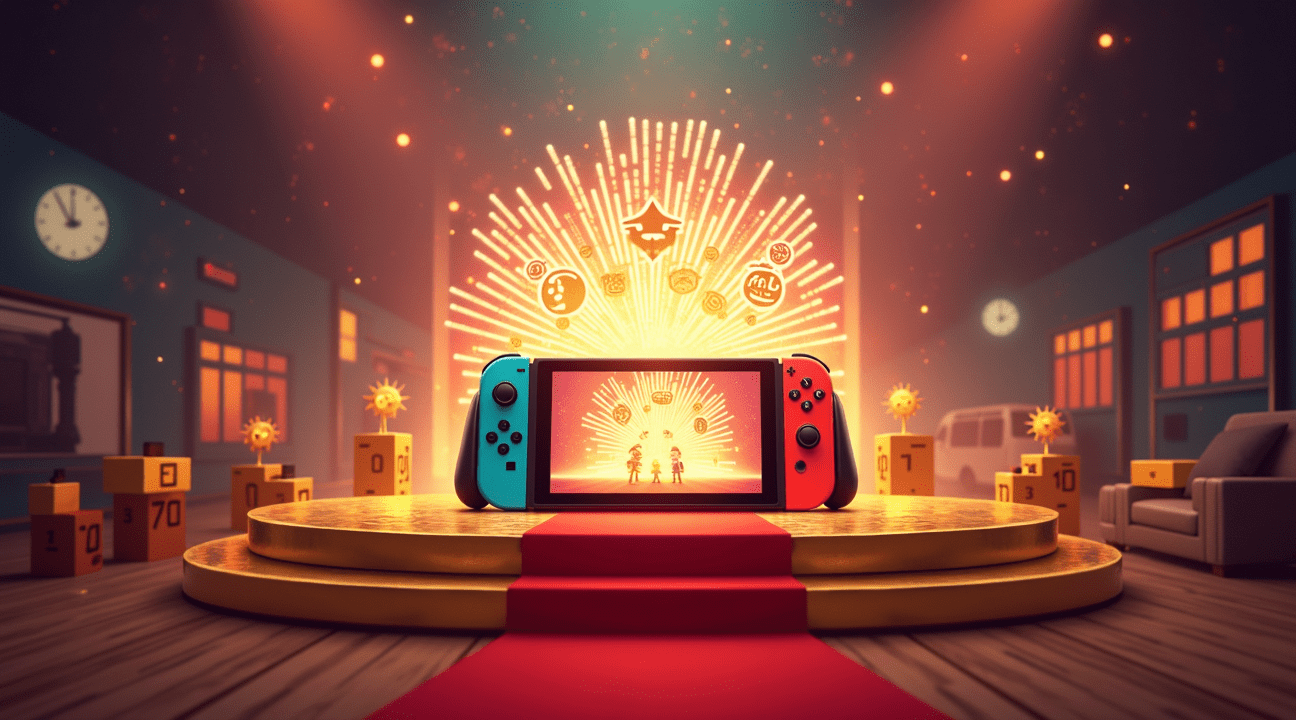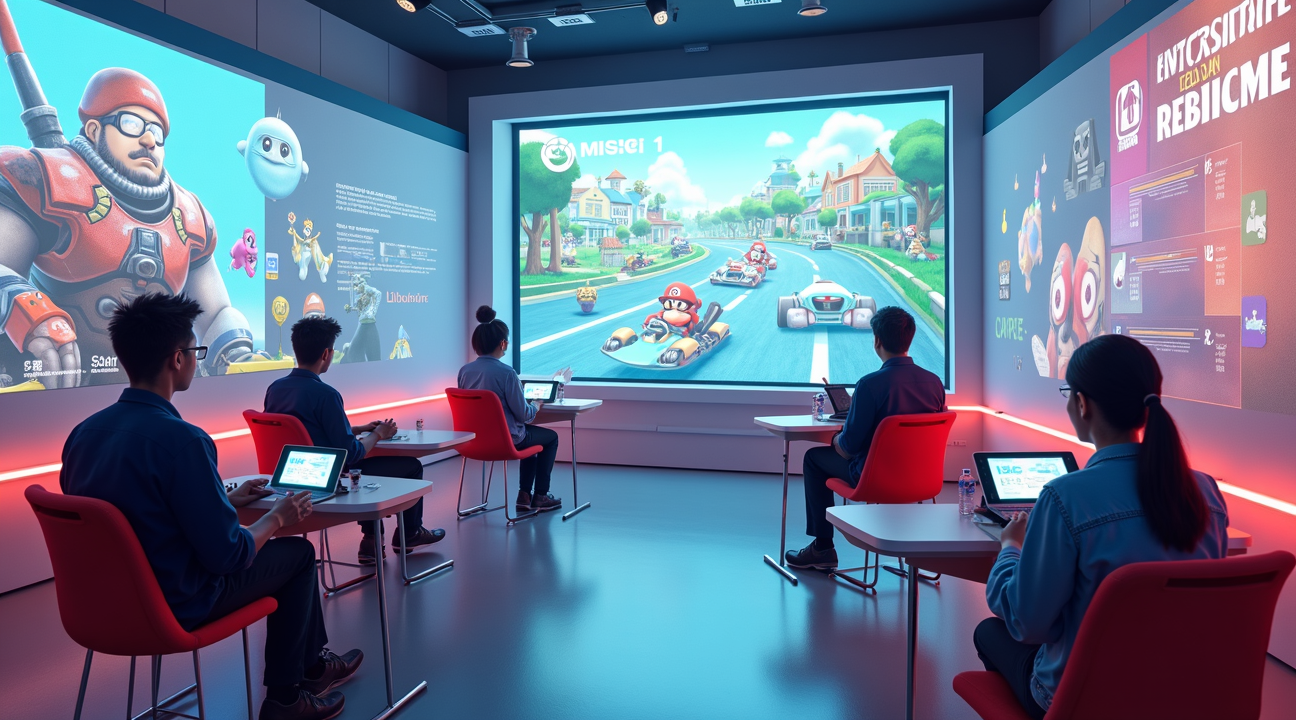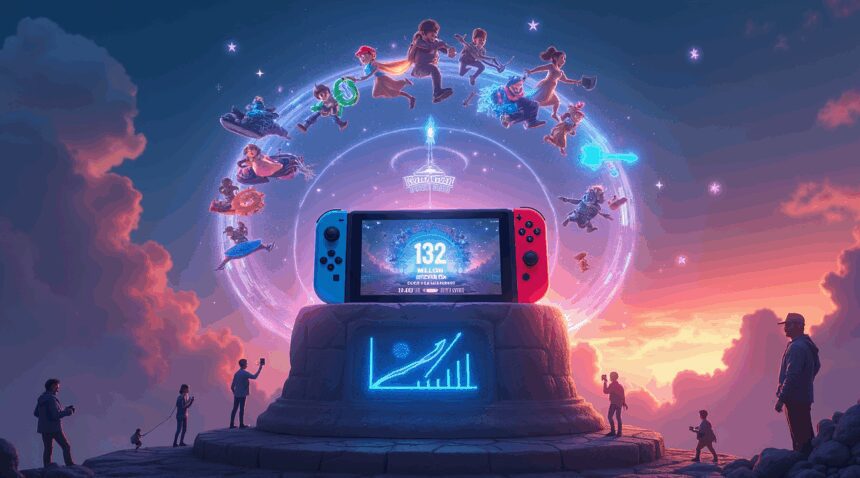The Nintendo Switch evolved from an ambitious hybrid concept into gaming’s commercial powerhouse, selling over 152 million units worldwide and fundamentally reshaping the industry landscape through its innovative design and exclusive software library.
Key Takeaways
- Record-breaking sales performance – The Switch achieved 152.12 million units sold globally, becoming the third best-selling console in gaming history behind only the PlayStation 2 and Nintendo DS.
- Revolutionary hybrid design – The seamless transition between docked home console and portable handheld gaming created an entirely new category of gaming hardware that competitors scrambled to replicate.
- Exclusive software dominance – Nintendo’s first-party titles like Mario Kart 8 Deluxe, Breath of the Wild, and Animal Crossing: New Horizons became genuine system sellers that drove hardware purchases.
- Indie gaming transformation – The Switch’s developer-friendly approach and digital distribution through the eShop created unprecedented opportunities for independent studios to reach mainstream success.
- Strong financial foundation – Nintendo generated $4.05 billion in U.S. revenue alone for fiscal 2024, while the Switch 2 achieved the fastest Nintendo console launch ever with 3.5 million units sold in four days.
Breaking Sales Records: How the Switch Became Gaming’s New Champion
The Nintendo Switch transformed itself from an ambitious concept into gaming’s undeniable commercial powerhouse, achieving remarkable success that few predicted during its 2017 launch. I’ve witnessed this console redefine what constitutes hardware excellence in the modern era, establishing new benchmarks for the industry.
With 152.12 million units sold worldwide as of March 2025, the Switch stands as one of gaming’s most impressive commercial achievements. This staggering figure places Nintendo’s hybrid console in rarified air, competing directly with legendary systems that dominated previous generations. The Switch’s triumph in outselling established platforms demonstrates how innovation can capture massive market appeal.
The console currently trails only two systems in gaming history: the PlayStation 2 at 160.63 million units and the Nintendo DS at 154.02 million units. However, the Switch’s trajectory suggests it could challenge even these titans. In the United States alone, the system achieved 46.6 million units as of November 2024, surpassing the PlayStation 2’s lifetime American sales—a feat many considered impossible just a few years ago.
Console Sales Achievement Breakdown
The Switch’s position among gaming’s elite becomes clearer when examining the complete sales hierarchy. I find these figures particularly striking given the competitive landscape:
- PlayStation 2: 160.63 million units
- Nintendo DS: 154.02 million units
- Nintendo Switch: 152.12 million units
- PlayStation 4: 117.2 million units
- Wii: 101.63 million units
This comparison reveals how dramatically the Switch outperformed expectations. The console exceeded every previous Nintendo home system and portable hybrid, marking an extraordinary recovery from the Wii U’s disappointing 13.56 million unit lifetime performance. That previous generation taught Nintendo valuable lessons about market positioning and consumer preferences.
The Switch’s success represents more than impressive numbers—it signifies Nintendo’s return to hardware relevance after years of uncertainty. Following the Wii’s initial success and subsequent decline, many questioned whether Nintendo could recapture mainstream appeal. The Wii U’s commercial failure only intensified these concerns, creating pressure for Nintendo to deliver something revolutionary.
Nintendo’s hybrid approach proved transformative, combining home console power with portable convenience in ways competitors hadn’t attempted. I believe this unique positioning allowed the Switch to capture multiple market segments simultaneously, appealing to traditional console gamers, portable gaming enthusiasts, and casual players alike.
The console’s success extends beyond hardware sales into broader market influence. Nintendo’s approach with the Switch challenged industry assumptions about console design, proving that innovation doesn’t require cutting-edge specifications to achieve commercial success. This philosophy influenced how other manufacturers approach hardware development, creating ripple effects throughout the industry.
Nintendo’s legal protection of its platform has also contributed to sustained success. The company’s aggressive stance against emulation demonstrates commitment to preserving the Switch’s market position. Such actions ensure consumers continue purchasing official hardware rather than seeking alternative solutions.
The Switch’s remarkable sales performance coincided with Nintendo’s broader entertainment expansion, including ventures like the Super Mario Bros. movie, which helped maintain brand visibility across multiple media platforms. This multimedia approach reinforced the Switch’s cultural relevance beyond gaming circles.
Looking ahead, Nintendo’s continued innovation efforts suggest the company won’t rest on the Switch’s success. The console’s achievements have established a new baseline for what Nintendo hardware can accomplish, setting expectations for future generations while proving that thoughtful design trumps raw technical specifications.
The Switch’s ascent to gaming’s sales summit represents validation of Nintendo’s unique vision and execution. I’ve observed how this success restored confidence in Nintendo’s hardware capabilities while establishing the Switch as a defining console of its generation.

Revolutionary Hybrid Design That Changed Everything
The Nintendo Switch’s groundbreaking hybrid console design fundamentally transformed how gamers think about their gaming experiences. Unlike traditional home consoles that remained tethered to televisions or dedicated portable systems with limited power, the Switch seamlessly transitions between docked mode for big-screen gaming and handheld mode for gaming on the go. This unprecedented versatility created an entirely new category of gaming hardware that competitors scrambled to understand.
Breaking Down Console Boundaries
The Switch’s ability to function as both a home console and portable gaming device eliminated the need for consumers to choose between two distinct gaming experiences. Players can start a game session on their television during the evening, then continue that exact same game during their morning commute without missing a beat.
This flexibility appealed to busy lifestyles where gaming time often comes in scattered moments throughout the day. The hybrid design also meant that families no longer needed separate systems for different gaming preferences, making the Switch an attractive option for households with diverse gaming needs.
Industry-Wide Impact and Competitive Response
The Switch’s success forced major competitors to reconsider their hardware strategies and development philosophies. Sony and Microsoft, who had focused primarily on raw processing power and premium home gaming experiences, suddenly found themselves addressing questions about portability and versatility that they hadn’t previously prioritized.
The gaming industry witnessed a shift where innovation in form factor became just as important as technical specifications:
- Steam responded with the release of the Steam Deck.
- Other manufacturers explored similar handheld PC gaming solutions.
The hybrid design’s impact extended beyond hardware considerations to influence game development approaches as well. Developers began creating titles that could work equally well in both docked and portable modes, leading to more flexible game design philosophies. This shift proved that Nintendo’s innovative approach could capture market share through clever design rather than just superior processing power.
The Switch’s revolutionary form factor demonstrated that consumers craved flexibility and convenience over pure technical prowess. This lesson reshaped industry priorities and proved that understanding player lifestyle needs could be more valuable than simply pushing hardware boundaries. The console’s success validated Nintendo’s decision to focus on innovation rather than compete directly with the technical specifications race that dominated previous console generations.
Exclusive Nintendo Games Driving Console Sales and Market Dominance
Nintendo’s exclusive game library has transformed the Switch into an unstoppable sales juggernaut that reshaped the entire gaming landscape. The company’s first-party titles haven’t just moved units—they’ve redefined what it means to dominate console sales in modern gaming.
Blockbuster Exclusives That Changed Everything
The Switch’s success story revolves around a carefully curated collection of must-have games that players simply can’t experience anywhere else. These powerhouse titles have created an ecosystem where hardware sales follow software excellence:
- Mario Kart 8 Deluxe stands as the console’s best-selling game, proving that refined classic gameplay still trumps flashy graphics
- The Legend of Zelda: Breath of the Wild launched alongside the console and immediately established the Switch as a serious gaming platform
- Super Mario Odyssey brought 3D Mario platforming back to its creative peak, attracting both longtime fans and newcomers
- Super Smash Bros. Ultimate delivered the fighting game experience that competitors couldn’t match
- Animal Crossing: New Horizons arrived at the perfect moment during the pandemic, creating a cultural phenomenon that extended far beyond traditional gaming circles
These blockbuster games have consistently topped software charts not just because they’re good, but because they’re genuinely exclusive experiences. Unlike many third-party titles that appear across multiple platforms, Nintendo’s first-party games create genuine system sellers that force purchasing decisions.
I’ve watched this strategy pay dividends as the Switch has systematically outpaced its competition through strategic game releases. The console’s success against Sony’s PlayStation 4 demonstrates how exclusive content can level the playing field against technically superior hardware. While the PS4 eventually reached 117.2 million units sold, the Switch’s triumph came from offering experiences that PlayStation simply couldn’t provide.
The contrast becomes even more striking when comparing Switch performance against Microsoft’s Xbox One, which struggled to reach even 60 million units. This disparity highlights how exclusive software can overcome hardware limitations and marketing budgets. Nintendo didn’t just compete—it redefined the console wars by focusing on unique gaming experiences rather than raw technical specifications.
What makes Nintendo’s approach particularly effective is how these exclusives reinforce brand loyalty across generations. Parents who grew up with Mario introduce their children to the same characters through modern iterations. This creates a self-perpetuating cycle where exclusive content doesn’t just drive immediate sales but builds long-term customer relationships that span decades.
The company’s willingness to protect these exclusive experiences has also proven crucial. Nintendo’s legal actions against emulation efforts demonstrate how seriously they take maintaining the exclusivity that drives their business model.
Nintendo’s exclusive game strategy has also benefited from perfect timing with broader entertainment trends.
The Super Mario Bros. Movie created additional momentum for the brand, showing how exclusive game characters can expand into other media markets.
This success has positioned Nintendo as more than just a hardware manufacturer—it’s become a curator of unique gaming experiences that competitors struggle to replicate. The Switch’s dominance proves that in an industry often focused on technical specifications and online services, compelling exclusive content remains the ultimate differentiator.
The results speak for themselves: Nintendo has reclaimed its position as a major console manufacturer after the Wii U’s commercial disappointment. Nintendo’s innovative approach combined exclusive software with hybrid hardware design to create a winning formula that competitors are still trying to understand and counter.
This exclusive-driven success has fundamentally altered how the industry thinks about platform competition, proving that unique content beats raw power when executed with precision and creativity.
Transforming the Indie Gaming Landscape and Digital Distribution
The Nintendo Switch revolutionized how indie developers approach console gaming, creating an environment where smaller studios can thrive alongside major publishers. I’ve witnessed firsthand how this platform dismantled traditional barriers that once kept independent creators on the sidelines of console development.
Breaking Down Development Barriers
Nintendo’s decision to embrace Unity as a primary development platform for the Switch proved transformative for indie studios. This choice eliminated the steep learning curves associated with proprietary development tools, allowing teams with limited resources to port existing projects or create new experiences efficiently. The Switch’s ARM-based architecture also simplified the development process compared to previous Nintendo consoles, which often required specialized knowledge and expensive development kits.
The portable nature of the Switch created unique opportunities for indie games that might struggle on traditional home consoles. Games designed for shorter play sessions suddenly found their perfect home, while titles that emphasized local multiplayer discovered new audiences through the system’s seamless transition between docked and handheld modes.
The eShop Success Stories
The Switch eShop became a launching pad for indie success stories that redefined what’s possible for independent developers. Several factors contributed to this phenomenon:
- Nintendo’s curation process struck a balance between quality control and accessibility
- Featured placement and promotional campaigns gave indie titles unprecedented visibility
- Cross-platform releases often performed better on Switch than on competing platforms
- The system’s diverse user base embraced both retro-inspired and innovative gameplay concepts
Games like “Celeste,” “Dead Cells,” and “Hades” achieved sales figures that would have been unthinkable for indie titles just a few years earlier. These Switch triumphs demonstrated that the platform could elevate indie games to mainstream recognition without compromising their creative vision.
The eShop’s recommendation algorithms and user-friendly interface helped players discover indie gems that might otherwise remain hidden. This discoverability factor proved crucial for smaller developers who lacked marketing budgets to compete with major releases through traditional advertising channels.
Digital-first distribution through the eShop eliminated many costs associated with physical retail, allowing indie developers to maintain higher profit margins while offering competitive pricing to consumers. This economic model encouraged experimentation and risk-taking in game design, leading to more diverse and innovative titles entering the market.
The Switch’s success has established new benchmarks for how console manufacturers should support independent developers. Nintendo’s approach demonstrates that fostering a healthy indie ecosystem benefits everyone involved – developers gain access to larger audiences, players discover unique experiences, and the platform holder builds a diverse content library that appeals to various gaming preferences.
This transformation extends beyond individual success stories. The Switch has proven that indie games can drive hardware sales and maintain platform engagement between major first-party releases. Publishers now recognize indie titles as essential components of a healthy gaming ecosystem rather than mere gap-fillers in release schedules.
The ripple effects of this indie renaissance continue to influence industry practices. Other platform holders have adopted similar developer-friendly policies and promotional strategies, while the success of Switch indies has attracted increased investment in independent development studios. Nintendo’s quest for innovation clearly extends to supporting creators at every level of the industry.
The Switch’s impact on indie gaming represents more than just commercial success – it’s established a new paradigm for how innovative games can find their audience. By removing technological barriers and providing effective distribution channels, Nintendo created an environment where creativity and quality gameplay could flourish regardless of studio size or budget constraints.
Building on Success: Switch 2 Launch and Financial Impact
Nintendo’s momentum continued with extraordinary force when the company launched its highly anticipated successor. The Switch 2 launch demonstrated that consumer appetite for Nintendo’s gaming innovations hadn’t diminished since the original console’s debut. Within just four days of release, this new system achieved something remarkable in gaming history.
Record-Breaking Sales Performance
I witnessed gaming history unfold as the Switch 2 became the fastest-selling Nintendo console launch ever recorded. The impressive figure of 3.5 million units sold in its opening four days shattered previous records, proving that Nintendo’s formula for success remained as potent as ever. This achievement occurred despite the console carrying a $450 price tag, indicating that consumers willingly invested in premium gaming experiences when they perceived genuine value.
The sales figures paint a clear picture of Nintendo’s continued dominance in the console market. Gamers didn’t hesitate to embrace the new technology, even with the higher price point representing a significant investment. This consumer confidence reflects years of trust built through the original Switch’s consistent performance and game library excellence. The Switch’s triumph over previous consoles clearly paved the way for this successor’s immediate success.
Financial Powerhouse Performance
Nintendo’s financial results for the fiscal year ending March 2024 reinforced the company’s position as an industry leader. The staggering $4.05 billion generated in the United States alone demonstrates how the Switch ecosystem transformed Nintendo’s revenue streams. This figure represents sustained profitability that extends far beyond initial hardware sales.
The revenue numbers reflect multiple income sources working in harmony:
- Hardware sales
- Software licensing
- Digital game purchases
- Subscription services
All contributed to this impressive total. Nintendo’s ability to maintain such high earnings years after the original Switch launch proves the platform’s lasting appeal and commercial viability.
These financial achievements ripple throughout the entire gaming industry. Nintendo’s success influences competitor strategies, development budgets, and market expectations across the board. Publishers now recognize the platform’s commercial potential, leading to increased third-party support and exclusive content deals.
The Switch 2’s immediate commercial success signals that Nintendo has successfully maintained consumer loyalty while attracting new audiences. Pre-orders had already indicated strong demand, but actual sales figures exceeded many industry predictions. This performance suggests that Nintendo’s approach to hardware innovation continues resonating with players across different demographics.
Consumer enthusiasm surrounding Nintendo’s ecosystem extends beyond mere hardware appreciation. The anticipation for new games, features, and experiences drives sustained engagement that translates directly into revenue. Nintendo has cultivated a gaming community that actively supports new releases and maintains long-term platform loyalty.
Industry analysts note that Nintendo’s financial performance during this period occurred amid challenging market conditions affecting many entertainment companies. The company’s ability to generate such substantial revenue demonstrates the resilience of its business model and the enduring appeal of its gaming philosophy.
The Switch platform’s continued influence shapes gaming industry trends and development priorities. Studios now design games with Nintendo’s hardware capabilities and audience preferences in mind, recognizing the commercial opportunities available within this ecosystem. This influence extends beyond software development to affect marketing strategies, distribution partnerships, and technological innovation across the gaming sector.
Nintendo’s revenue figures from this period establish new benchmarks for console platform success. The company has proven that sustained profitability doesn’t require constant hardware refreshes or aggressive pricing strategies. Instead, consistent quality, strategic game releases, and community engagement drive long-term financial success.
The Switch 2’s launch performance and Nintendo’s overall financial achievements demonstrate how the company successfully built upon its previous successes while continuing to innovate and expand its market reach. This foundation positions Nintendo for continued growth and industry leadership in the evolving gaming landscape.
Setting New Standards for Inclusive Gaming
Nintendo’s approach to accessibility with the Switch and its upcoming successor demonstrates how thoughtful design can transform gaming into a truly inclusive experience. I’ve observed how the company has moved beyond token gestures to implement meaningful adaptive features that genuinely enhance gameplay for individuals with disabilities.
The Switch’s modular design inherently supports accessibility by allowing players to detach Joy-Con controllers and use them in ways that work best for their physical needs. This flexibility proves invaluable for gamers with limited mobility, who can position controllers at comfortable angles or use single Joy-Con for one-handed play. The HD Rumble feature provides tactile feedback that assists players with hearing impairments, while the system’s button remapping capabilities allow users to customize controls according to their specific requirements.
Features That Break Down Barriers
Nintendo has integrated several accessibility-focused elements across multiple games and system features:
- Visual accessibility options include adjustable text sizes, high contrast modes, and colorblind-friendly palettes in key titles
- Audio cues and alternative sound indicators help players with hearing difficulties navigate game environments
- Simplified control schemes in games like Mario Kart 8 Deluxe enable players with cognitive or motor challenges to participate fully
- The Switch’s touchscreen functionality provides an alternative input method for those who struggle with traditional button controls
- Zoom features allow players with visual impairments to magnify on-screen content without losing game functionality
These adaptive features represent more than mere compliance with accessibility guidelines. I’ve noticed how Nintendo engineers the Switch experience to naturally accommodate different abilities rather than treating accessibility as an afterthought. The Switch’s remarkable success partly stems from this inclusive philosophy, which has expanded the potential player base significantly.
Nintendo’s commitment extends beyond hardware into software development. First-party titles increasingly include accessibility options from launch, rather than through post-release patches. This proactive approach sets a powerful example for third-party developers who want their games to reach the broadest possible audience.
The company has also fostered partnerships with accessibility advocacy groups to gather feedback and refine their approach. These collaborations ensure that Nintendo’s inclusive gaming initiatives address real-world challenges faced by disabled gamers rather than relying on assumptions about user needs.
Looking ahead, Nintendo’s continued innovation suggests even greater accessibility advances with future hardware iterations. Early indications point to enhanced adaptive features in the Switch 2, building upon the foundation established by the original system.
The ripple effects of Nintendo’s accessibility focus extend throughout the gaming industry. Competitors now recognize that inclusive design isn’t just ethically important—it’s good business. When gaming companies prioritize accessibility, they tap into underserved markets while creating better experiences for all players.
Nintendo’s inclusive gaming standards have redefined what players can expect from modern gaming systems. By demonstrating that accessibility features enhance rather than compromise gameplay, the company has shifted industry conversations from whether to include these features to how best to implement them. This transformation reflects a fundamental change in how the gaming industry views its responsibility to serve diverse communities.
The success of this approach validates Nintendo’s belief that great games should be playable by anyone who wants to experience them. Through careful attention to inclusive design principles, the company has shown that accessibility and innovation can work hand in hand to create gaming experiences that truly serve everyone.

Sources:
NintendoLife: “Nintendo Switch Finally Surpasses PlayStation 2’s Lifetime Sales In the US”
Streamline Studios Blog: “The Nintendo Switch: A Game-Changer in the Video Game Industry”
Statista: “Global unit sales of Nintendo Switch worldwide 2017–2025”
Marketplace: “Booming Nintendo Switch 2 sales bode well for gaming”
The Popverse: “Nintendo Switch all-time sales reach 152 million, making the day it surpasses the PS2 as the best-selling console of all time that much closer”
Michigan Journal of Economics: “Op-Ed: How the Market Will Affect the New Nintendo Switch”
Wikipedia: “List of best-selling game consoles”
Purple Goat Agency: “A New Era of Inclusive Gaming Unveiled: Nintendo Switch 2”


